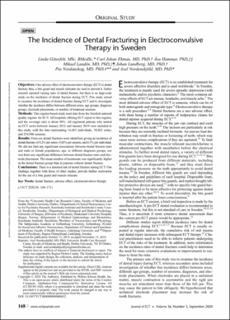| dc.description.abstract | Objectives: One adverse effect of electroconvulsive therapy (ECT) is dental fracture; thus, a bite guard and muscle relaxants are used to prevent it. Earlier research reported varying rates of dental fracture, but there is no large-scale study on the incidence of dental fracture during ECT. This study aimed to examine the incidence of dental fracture during ECT and to investigate whether the incidence differs between different sexes, age groups, diagnosis groups, electrode placements, or number of treatment sessions.
Methods: This register-based study used data from the Swedish national quality register for ECT. All hospitals offering ECT report to this register, and the coverage ratio is about 90%. All registered patients who started an ECT series between January 2012 and January 2019 were included in this study, with the data representing 16,681 individuals, 38,862 series, and 254,906 sessions.
Results: Forty-six dental fractures were identified, giving an incidence of dental fracture of 0.2% per series, 0.02% per session, and 0.3% per individual. We did not find any significant associations between dental fracture rates and male or female populations, age, or different diagnosis groups, nor was there any significant difference between dental fracture rates and electrode placement. The mean number of treatments was significantly higher in the dental fracture group than in patients without dental fracture.
Conclusions: There is a minimal risk of dental fracture during ECT. Our findings, together with those of other studies, provide further motivation for the use of a bite guard and muscle relaxant. | en_US |

